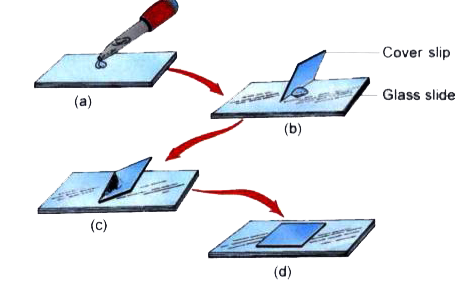Smear a drop of fresh buttermilk on a glass slide. Stain it with methylene blue and put a coverslip over it.
Observe the smear under the 10X objective of a compound microscope and then with the more powerful 60X objective. Did you notice the blue rod-shaped organisms Moving, around? Solution in Marathi
Step by step video & image solution for Smear a drop of fresh buttermilk on a glass slide. Stain it with methylene blue and put a coverslip over it. Observe the smear under the 10X objective of a compound microscope and then with the more powerful 60X objective. Did you notice the blue rod-shaped organisms Moving, around? by Biology experts to help you in doubts & scoring excellent marks in Class 9 exams.
Updated on:21/07/2023Topper's Solved these Questions
Similar Questions
Choose the correct alternative
Due to the effect of root pressure, water and minerals reach_________of the roots.
View SolutionIf the red light is replaced by blue light illuminating the object in a microscope the resolving power of the microscope
View SolutionA smear of blood from a healthy individual is stained with a nuclear stain called hematoxylin and then observed under a light microscope. Which of the following cell type would be highest in number ?
View SolutionFind the inappropriate term: ocular lens, mirror, objective lens, methylene blue.
View SolutionIf the light is replaced by blue light illuminating the object in a microscope then the resolving power of the microscope
View SolutionLet us take a glass slide with a drop of water on it. Using an ice cream spoon gently scrape the inside surface of the cheek. Does any material get stuck on the spoon ? With the help of a needle we can transfer this material and spread it evenly on the glass slide kept ready for this. To colour the material we can put a drop of methylene blue solution on it. Now the material is ready for observation under microscope. Do not forget to put a cover-slip on it. What do we observe? What is the shape of the cells we see?
View SolutionTo observe filamentous algae under microscope. Apparatus : Microscope, slide, coverslip. Materials : Glycerine, pond water, blotting paper. Procedure : rarr Collect water from a lake or pond that appears dark green and contains filamentous structure. rarr Put one or two filaments on a slide. Put a drop of glycerine on the filaments and cover it with a coverslip. rarr Observe the slide under a microscope. State the example of filamentous organism.
View SolutionTo observe filamentous algae under microscope.
Apparatus : Microscope, slide, coverslip.
Materials : Glycerine, pond water, blotting paper.
Procedure :
→ Collect water from a lake or pond that appears dark green and contains filamentous structure.
→ Put one or two filaments on a slide.
Put a drop of glycerine on the filaments and cover it with a coverslip.
→ Observe the slide under a microscope.

Can you identify different tissues in the filaments ?
View SolutionTo observe filamentous algae under microscope.
Apparatus : Microscope, slide, coverslip.
Materials : Glycerine, pond water, blotting paper.
Procedure :
→ Collect water from a lake or pond that appears dark green and contains filamentous structure.
→ Put one or two filaments on a slide.
Put a drop of glycerine on the filaments and cover it with a coverslip.
→ Observe the slide under a microscope.

Why is filament of spirogyra green in colour ?
View SolutionTo observe filamentous algae under microscope.
Apparatus : Microscope, slide, coverslip.
Materials : Glycerine, pond water, blotting paper.
Procedure :
→ Collect water from a lake or pond that appears dark green and contains filamentous structure.
→ Put one or two filaments on a slide.
Put a drop of glycerine on the filaments and cover it with a coverslip.
→ Observe the slide under a microscope.

Is spirogyra a prokaryotic or eukaryotic organism ?
View SolutionTo observe filamentous algae under microscope. Apparatus : Microscope, slide, coverslip. Materials : Glycerine, pond water, blotting paper. Procedure : rarr Collect water from a lake or pond that appears dark green and contains filamentous structure. rarr Put one or two filaments on a slide. Put a drop of glycerine on the filaments and cover it with a coverslip. rarr Observe the slide under a microscope. How do spirogyra reproduce asexually ?
View SolutionObserve a permanent slide of blood smear under a compound microscope. What did you see?
View SolutionCollect different water samples of fresh water. Mount them on a glass slide and observe under a compound microscope. Try to identify the organisms which are visible under it.
View SolutionTake a few drops of water from a pond. Spread on a glass slide and observe through a microscope. Do you find tiny organisms moving around?
View SolutionGently put the object to be observed in the drop of water on the slide with help of a brush ( objects . If transparent are first stained with a proper chemical and then observed . This is

done to obtain suitable contranst to facilitate ease viewing .)
View SolutionActivity-based question :
Activity : Take a small drop of curd or buttermilk on a clean glass slide. Dilute it with a little water. Carefully keep a coverslip. Observe ot under high power of compound microscope. What did you see ?
View Solution
